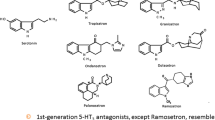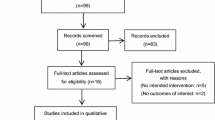Abstract
Purpose
To investigate the association between adherence to guideline-recommended risk-based postoperative nausea and vomiting (PONV) prophylaxis, the antiemetics used for PONV prophylaxis, and the incidence of PONV in patients who were underwent general anesthesia before and after 5-HT3 receptor antagonists became available.
Methods
Patients (≥ 20 years old) who were extubated after scheduled surgery and returned to general wards between January 2021 and February 2022 and between June 2022 and July 2023 were included. Risk factors included age < 50, female, motion sickness, nonsmoker, surgical factors, and postoperative opioid use. Two and three or more prophylaxis were recommended for patients with one or two and three or more risk factors, respectively. The primary outcome was the number of patients who received adequate prophylaxis, and the secondary outcomes were antiemetic agents used during anesthesia and the incidence of PONV on postoperative days 0 and 1. PONV was defined as documented PONV or rescue antiemetic administration.
Results
From January 2021 to February 2022 and from June 2022 to July 2023, 2342 and 2682 patients were included, respectively. Before ondansetron became available, more D2 receptor antagonists were used (p < 0.001), and after ondansetron became available, both ondansetron (p < 0.001) and propofol (p < 0.001) were given more frequently. Before and after ondansetron became available, the number of patients with adequate prophylaxis was 3.7% and 9.2%, respectively (p < 0.001), and the incidence of PONV on postoperative days 0 and 1 was 44.6% and 44.0%, respectively (p = 0.67).
Conclusion
The availability of ondansetron increased the number of patients with adequate PONV prophylaxis, but did not decrease the incidence of PONV.

Similar content being viewed by others
Data availability
The data supporting the findings of this study are available from the corresponding author upon reasonable request.
References
Gan TJ, Belani KG, Bergese S, Chung F, Diemunsch P, Habib AS, Jin Z, Kovac AL, Meyer TA, Urman RD, Apfel CC, Ayad S, Beagley L, Candiotti K, Englesakis M, Hedrick TL, Kranke P, Lee S, Lipman D, Minkowitz HS, Morton J, Philip BK. Fourth consensus guidelines for the management of postoperative nausea and vomiting. Anesth Analg. 2020;131:411–48.
Kehlet H, Dahl JB. Anaesthesia, surgery, and challenges in postoperative recovery. Lancet. 2003;362:1921–8.
Apfel CC, Läärä E, Koivuranta M, Greim CA, Roewer N. A simplified risk score for predicting postoperative nausea and vomiting: conclusions from cross-validations between two centers. Anesthesiology. 1999;91:693–700.
Myles PS, Williams DL, Hendrata M, Anderson H, Weeks AM. Patient satisfaction after anaesthesia and surgery: results of a prospective survey of 10,811 patients. Br J Anaesth. 2000;84:6–10.
Hill RP, Lubarsky DA, Phillips-Bute B, Fortney JT, Creed MR, Glass PS, Gan TJ. Cost-effectiveness of prophylactic antiemetic therapy with ondansetron, droperidol, or placebo. Anesthesiology. 2000;92:958–67.
Practical guideline for medication provided by Japanese Society of Aneshtesiology https://anesth.or.jp/files/pdf/other_medicine_20190905.pdf (final access on 20th November, 2023.)
Yunoki K, Mima H. Postoperative nausea and vomiting after artificial joint replacement surgery: comparison between remimazolam and sevoflurane, a propensity score analysis. J Anesth. 2023;37:666–71.
Suzuki Y, Kawashima S, Makino H, Doi M, Nakajima Y. Comparison of postoperative nausea and vomiting between remimazolam and propofol: a propensity score-matched, retrospective, observational, single-center cohort study Korean. J Anesthesiol. 2023. https://doi.org/10.4097/kja.22441.
Choi JY, Lee HS, Kim JY, Han DW, Yang JY, Kim MJ, Song Y. Comparison of remimazolam-based and propofol-based total intravenous anesthesia on postoperative quality of recovery: a randomized non-inferiority trial. J Clin Anesth. 2022;82: 110955.
Gan TJ, Meyer T, Apfel CC, Chung F, Davis PJ, Eubanks S, Kovac A, Philip BK, Sessler DI, Temo J, Tramèr MR, Watcha M. Department of anesthesiology, duke university medical center. consensus guidelines for managing postoperative nausea and vomiting. Anesth Analg. 2003;97:62–71.
By the 2019 American Geriatrics Society Beers Criteria® Update Expert Panel. American Geriatrics Society. Updated AGS beers criteria® for potentially inappropriate medication use in older adults. J Am Geriatr Soc. 2019;2019(67):674–94.
Peyton PJ, Liskaser G, Ho A, Marsh H, Etherington C, Torlot F, Desai M, Perrett G, Chee B, Leslie K, Myles PS. Postoperative pulmonary complications in the ENIGMA II trial: a post hoc analysis. Anesthesiology. 2023;138:354–63.
Gabel E, Shin J, Hofer I, Grogan T, Ziv K, Hong J, Dhillon A, Moore J, Mahajan A, Cannesson M. Digital quality improvement approach reduces the need for rescue antiemetics in high-risk patients: a comparative effectiveness study using interrupted time series and propensity score matching analysis. Anesth Analg. 2019;128:867–76.
Kappen TH, Vergouwe Y, van Wolfswinkel L, Kalkman CJ, Moons KG, van Klei WA. Impact of adding therapeutic recommendations to risk assessments from a prediction model for postoperative nausea and vomiting. Br J Anaesth. 2015;114:252–60.
Dewinter G, Staelens W, Veef E, Teunkens A, Van de Velde M, Rex S. Simplified algorithm for the prevention of postoperative nausea and vomiting: a before-and-after study. Br J Anaesth. 2018;120:156–63.
Acknowledgements
The authors would like to thank Editage (www.editage.com) for the English language editing.
Funding
None.
Author information
Authors and Affiliations
Corresponding author
Ethics declarations
Conflict of interest
The authors have no conflicts of interest.
Ethics approval
Ethical approval for this study (Approval No. 3962, Chairperson: Prof. M. Yoshizumi) was provided by the local ethics committee on 6 September 2023.
Informed consent
Informed consent was waived.
Additional information
Publisher's Note
Springer Nature remains neutral with regard to jurisdictional claims in published maps and institutional affiliations.
Supplementary Information
Below is the link to the electronic supplementary material.
About this article
Cite this article
Hirai, S., Ida, M. & Kawaguchi, M. Comparison of prophylaxis strategy for postoperative nausea and vomiting and its incidence before and after the implementation of 5-hydroxytryptamine 3 in surgical setting: a single-center, retrospective study. J Anesth 38, 398–404 (2024). https://doi.org/10.1007/s00540-024-03327-3
Received:
Accepted:
Published:
Issue Date:
DOI: https://doi.org/10.1007/s00540-024-03327-3




